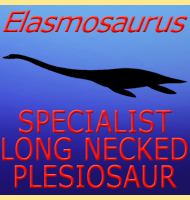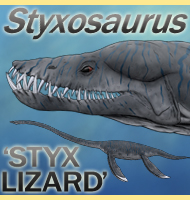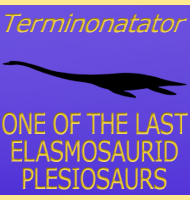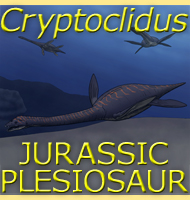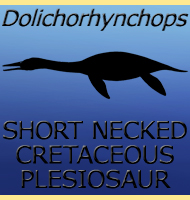


Aristonectes
Name:
Aristonectes
(Best swimmer).
Phonetic: Ah-riss-toe-nek-teez.
Named By: Cabrera - 1941.
Classification: Chordata, Reptilia,
Sauropterygia, Plesiosauria, Aristonectidae.
Species: A. parvidens (type),
A. quiriquinensis.
Diet: Filter feeder.
Size: Uncertain due to incomplete remains. Skull
of holotype approximately 32-33 centimetres long. Full body length
roughly estimated around ten meters long.
Known locations: Antarctica, Argentina - Paso
del Sapo Formation, Chile.
Time period: Maastrichtian of the Cretaceous.
Fossil representation: Three sets of remains of
partial skull material, cervical (neck) vertebrae and partial
limb elements.
While
the plesiosaurs
are usually seen as predators of fish Aristonectes
took the different and much more specialist path of filter feeder.
The teeth in the jaws were very short with crowns that were less than
one centimetre high. There were a high number of these teeth which
were densely packed together in jaws that were both proportionately
long and wide compared to other plesiosaur skulls. This was to
provide Aristonectes with the largest possible
‘catch area’ for
small aquatic invertebrates that would have been eaten in huge numbers
in order to keep its body going. It’s likely that Aristonectes
would have swallowed gastroliths like other plesiosaurs did, not only
for ballast but grinding food in the stomach. In the case of
Aristonectes this would mean the shells of the
invertebrates that it
ate so that the soft flesh within could be more easily digested.
The
most commonly used analogy for Aristonectes is its
comparison to the
crabeater seal (Lobodon carcinophagus) which
lives around
Antarctica. Despite the name crabeater seals feed mostly upon krill
while taking the occasional fish or cephalopods. Krill are open
water crustaceans that are similar to shrimps, and are especially
abundant in the cooler waters of the Antarctic (although the
Cretaceous seas were warmer than todays, they still would have been
slightly cooler towards the poles). Krill today grow up to six
centimetres long and gather in swarms that are measured in their
hundreds of thousands. All an animal has to do is swim into these
concentrations and sieve the water with its teeth to get a mouthful of
highly nutritious sea food. With Aristonectes
feeding on such small
but abundant animals, it could avoid direct competition with the
other marine reptiles that were more generalist carnivores.
Aristonectes
sits quite comfortably within its own group of the Aristonectidae,
its wider position amongst other plesiosaurs remains uncertain.
Wider and more recent opinion places Aristonectes
as an elasmosaurid,
but in the past it has been considered as a cryptoclidoid. The one
thing that could help in resolving the uncertainty is new and much
better preserved fossils that would allow for a complete analysis of
the whole animal.
Further reading
- Un plesiosaurio nuevo del Cret�ceo del Chubut. - Revista del Museo de
La Plata 2(8):113-130. - A. Cabrera - 1941.
- The elasmosaurid plesiosaur Aristonectes Cabreta
from the Latest
Cretaceous of South America and Antarctica. - Journal of Vertebrate
Paleontology 23(1): 104-115. - Z. Gasparini, N. Bardet, , J. E. martin
& M. S. Fernandez - 2003.
- A postcranial skeleton of an elasmosaurid plesiosaur from the
Maastrichtian of central Chile, with comments on the affinities of Late
Cretaceous plesiosauroids from the Weddellian Biogeographic Province. -
Cretaceous Research, 37: 89–99. - R. A. Otero, S. Soto-Acu�a &
D. Rubilar-Rogers - 2012.
- Aristonectes quiriquinensis sp. nov., a new
highly derived
elasmosaurid from the upper Maastrichtian of central Chile. - Journal
of Vertebrate Paleontology 34(1):100-125. - R. A. Otero, S. Soto-Acu�a,
F. R. O'Keefe, J. P. O'Gorman, W. Stinnesbeck, M. E. Su�rez, D.
Rubilar-Rogers, C. Salazar & L. A. Quinzio-Sinn - 2014.
- Cranial anatomy of Morturneria seymourensis from
Antarctica, and the
evolution of filter feeding in plesiosaurs of the Austral Late
Cretaceous. - Journal of Vertebrate Paleontology. - F. O'Keefe, R.
Otero, S. Soto-Acu�a, J. O'gorman, S. Godfrey & S. Chatterjee -
2017.
- Osteology of Aristonectes quiriquinensis (Elasmosauridae,
Aristonectinae). - Journal of Vertebrate Paleontology. 38 (1).
e1408638. - Rodrigo A. Otero, Sergio Soto-Acu�a & Frank R.
O'keefe - 2018.
----------------------------------------------------------------------------
Random favourites
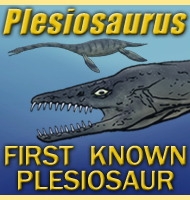 |
 |
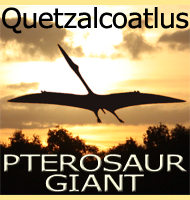 |
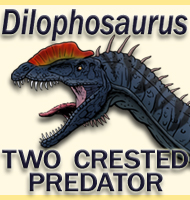 |
